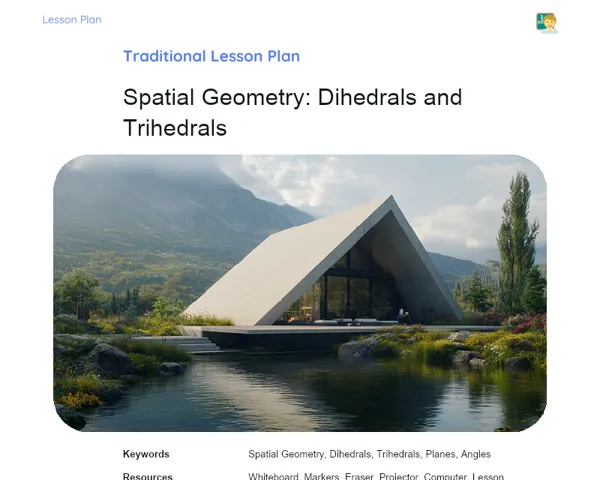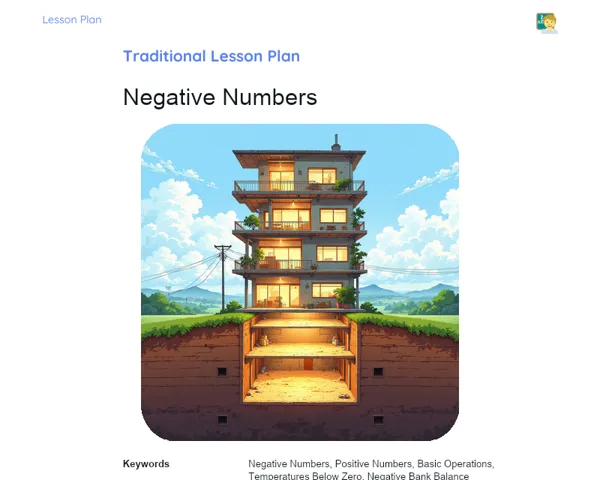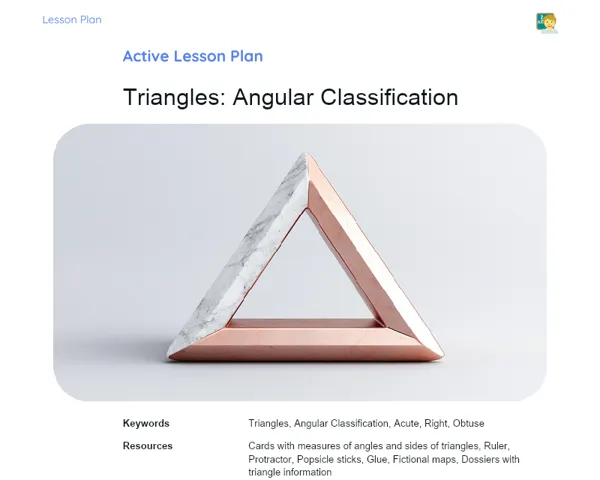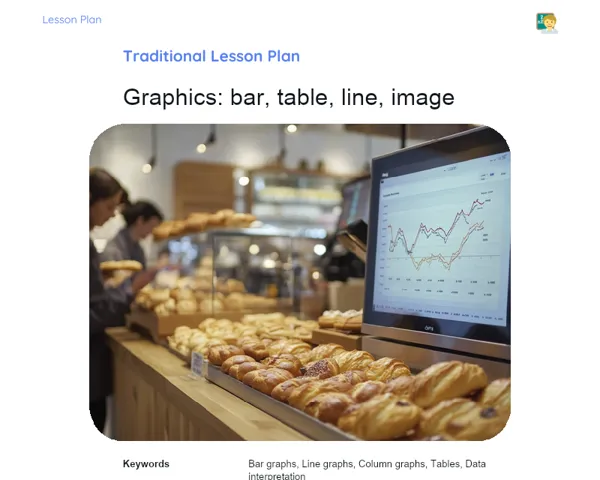Lesson Plan | Lesson Plan Iteratif Teachy | Angles: Degrees and Radians
| Keywords | Angles, Degrees, Radians, Conversion, Digital Methodology, Practical Activities, High School Grade 9, TikTok, Instagram, YouTube, Google Forms, QR Codes, Digital Escape Room, Collaboration, Engagement, Storytelling, 360° Feedback |
| Resources | Cell phones with internet access, Computers or tablets, Video editing apps (preferably free), Google Forms, QR Codes, Google Classroom, Google Slides, Projector or large screen (for presentations), Materials for note-taking (notebook and pen or digital note-taking apps) |
| Codes | - |
| Grade | 10th grade |
| Discipline | Mathematics |
Goal
Duration: 10 - 15 minutes
This stage outlines specific objectives to guide the lesson, highlighting the significance of mastering the conversion between degrees and radians, which is pivotal for tackling practical mathematical issues. This will set the stage for the hands-on activities and discussions that will unfold.
Goal Utama:
1. Help learners convert angles between degrees and radians.
2. Enable learners to solve real-world problems involving angle conversions, such as demonstrating that 180° equals π radians.
Goal Sekunder:
Introduction
Duration: 10 - 15 minutes
This stage aims to capture learners' attention right from the start, engaging them through real-world examples and quick research. The introduction bridges their existing knowledge with the practical aspects to be explored in the lesson. The key questions initiate dialogue that reinforces foundational understanding and prepares the learners for deeper engagement.
Warming Up
🌟 Warm-up: Begin the lesson by discussing how angles are relevant in our everyday lives, using examples like GPS navigation and engineering. Briefly share that today’s focus will be on converting between degrees and radians—a topic they've encountered before. Then, encourage learners to use their phones to uncover an interesting fact about angles, whether in degrees or radians, and present it to the class. This will pique their interest and showcase the real-world significance of the topic.
Initial Thoughts
1. 📊 What distinguishes degrees from radians?
2. 💡 Why is it crucial to be able to convert between degrees and radians?
3. 🧐 In which day-to-day scenarios do you think converting between degrees and radians is necessary?
4. 🔄 How would you explain converting degrees to radians to someone who knows nothing about it?
5. 📜 Why do we say 180° is the same as π radians? Can someone shed light on this relationship?
Development
Duration: 70 - 80 minutes
This stage is designed to offer learners a hands-on, engaging education experience where they apply their existing knowledge about converting angles from degrees to radians and back. The activities foster creativity, teamwork, and digital skills, making learning more relevant and exciting.
Activity Suggestions
Activity Recommendations
Activity 1 - Angle Influencers!
> Duration: 60 - 70 minutes
- Goal: Encourage learners to explain mathematical concepts in an engaging and creative way, using popular digital platforms and storytelling techniques.
- Deskripsi Activity: Learners will create short videos emulating digital influencers, explaining the conversion of degrees to radians. They can choose popular platforms like TikTok, Instagram, or YouTube to craft their educational and creative content to communicate the topic in an accessible manner.
- Instructions:
-
Divide learners into groups of up to 5 members.
-
Each group selects a social media platform (TikTok, Instagram, or YouTube).
-
Instruct them to create a short video (1-3 minutes), creatively explaining the conversion between degrees and radians.
-
Videos can feature skits, animations, drawings, or other inventive approaches.
-
Encourage the use of video editing apps accessible on their phones or computers.
-
Groups should upload their videos onto a class video-sharing platform or a private social media group.
-
Reserve the final 10 minutes for groups to present their videos and discuss their creative choices.
Activity 2 - Digital Angle Treasure Hunt
> Duration: 60 - 70 minutes
- Goal: Promote teamwork and practical application of conversion concepts through an engaging, fun-filled experience.
- Deskripsi Activity: Learners will join a digital treasure hunt, solving riddles and tasks related to converting angles in degrees and radians. Using tools like Google Forms and QR Codes, they will follow a series of clues leading to a final challenge.
- Instructions:
-
Divide learners into groups of up to 5 members.
-
Create a Google Form containing riddles and tasks that involve converting degrees to radians.
-
Each riddle or task must be solved to unlock the next clue, accessed via QR Codes placed around the room or links in the Google Form.
-
Ensure the tasks are varied and interactive, incorporating multiple-choice questions, open-ended queries, and small calculations.
-
Inform them that the first team to complete the treasure hunt wins a small prize (like a digital certificate or tokens).
-
Dedicate the last 10 minutes to review the riddles and highlight key learnings.
Activity 3 - Angle Game: Digital Escape Room
> Duration: 60 - 70 minutes
- Goal: Encourage collaboration and critical thinking through a gamified experience, prompting learners to apply their knowledge practically and in a fun manner.
- Deskripsi Activity: Learners will take part in a digital escape room, where they solve problems and challenges about angles in degrees and radians to 'escape' the virtual room. Using platforms like Google Classroom and Google Slides, they will collaborate to progress through the stages.
- Instructions:
-
Form groups of up to 5 members.
-
Create a Google Slides presentation acting as the 'map' of the escape room, including links and challenges in each slide.
-
Each slide should contain a problem or task involving converting degrees to radians. Only upon solving the problem can they advance to the next slide (or room).
-
Incorporate various problem formats—like multiple-choice, practical calculations, and real-life scenarios that require angle conversions.
-
Explain that the aim is to solve all challenges to 'escape' the virtual room.
-
In the last 10 minutes, gather all groups for a reflective discussion about strategies and solutions.
Feedback
Duration: 20 - 25 minutes
The aim of this stage is to consolidate learning through reflection and shared experiences. The group discussion allows learners to articulate their insights and challenges, linking the studied content with real-life applications. The 360° feedback fosters communication and collaboration skills, crucial for personal and academic development.
Group Discussion
🔄 Group Discussion: Lead a discussion with the learners, encouraging them to share what they discovered throughout the activities. Use the following points to steer the conversation:
- Introduction: Ask each group to briefly describe their activity and the main hurdles they encountered.
- Learnings: Ask them to share the most valuable insights gained during their video creations, the treasure hunt, or the escape room.
- Practical Applications: Facilitate a chat on how understanding conversions between degrees and radians can be applied in everyday scenarios.
- Technological Aspects: Inquire about the digital tools they employed and how these tools supported their grasp of the mathematical elements.
Reflections
1. 🌍 How did creating digital content enhance your understanding of converting degrees to radians? 2. 🔍 What were the biggest challenges faced during these activities, and how did you tackle them? 3. 📱 How did the digital tools used in the lesson facilitate your learning experience?
Feedback 360º
🔄 360° Feedback: Guide students to engage in a 360° feedback session, where each individual should give and receive constructive feedback among their group members. Encourage a respectful atmosphere by using the Sandwich feedback method (Praise, Constructive Criticism, Praise). Provide examples of constructive feedback to help cultivate an environment of support among peers.
Conclusion
Duration: 10 - 15 minutes
This stage aims to reinforce learning in a fun, light-hearted manner, underscoring how the knowledge gained applies in the real world. It provides learners with tangible connections to the content, cementing their understanding and showcasing the relevance of angles in both degrees and radians in their everyday activities.
Summary
🎉 Angle Show Summary!: Today, we danced between degrees and radians! 🎶 We tackled converting 180° to π radians like true math celebs! 🌐 Our learners engaged in exciting digital activities—from crafting influencer-style videos 🎥 to the exhilarating races of the digital treasure hunt 🏃♀️🤖 and the suspense of the math escape room 🏁🔑.
World
🌍 In Today's World: In our tech-driven era, understanding angles is critical! Be it in engineering, game design, digital art, or crafting GPS navigation algorithms, angles hold immense significance. The transition between degrees and radians is not merely an academic exercise but a mathematical language vital in today's tech age.
Applications
📌 Applications: Mastering conversion between degrees and radians is essential in our daily lives! Whether adjusting a drone’s camera, calculating the ball’s trajectory in a football match, or understanding the curves of your smartphone screen, these conversions bring clarity and precision to both the digital and physical realms.



